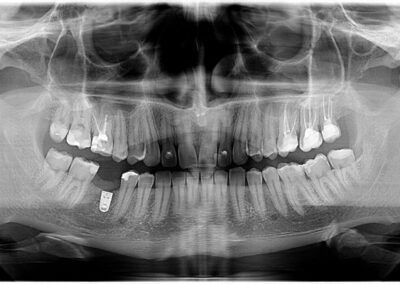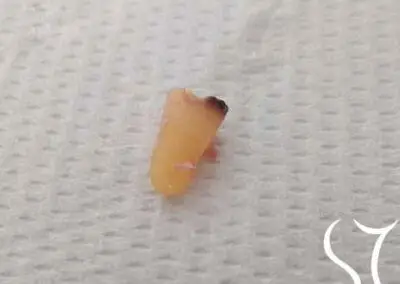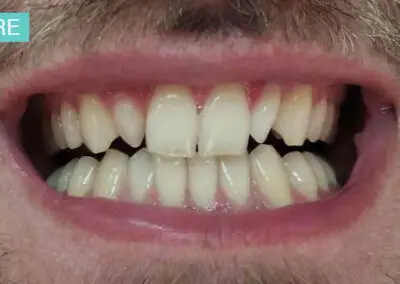Prostheses
All-ceramic work
Case 1
Our patient was unhappy with the look of the metal ceramic crowns she had on her two left-side incisors. It is important to note that not only were the crowns cosmetically unappealing, they were also defective: the gums around them were inflamed, degrading the health of the supporting structures of the teeth and causing medical and additional aesthetic problems.
The problem was fully resolved in this case by putting in all-ceramic crowns and treating the inflammation of the gums.
Case 2
The patient was unhappy with the appearance of her teeth – their misalignment and discolouration. In this case the issue was resolved using individual all-ceramic crowns.
Metal ceramic work
Case 1
Frontal metal-ceramic bridge, ensuring aesthetic considerations are fully met at the site.
The patient suffered a fall from his bicycle and damaged his old metal ceramic bridge.
In view of the extent of the damage, manufacture of a new prosthesis was indicated. The patient was presented with all the treatment options for his situation, after which he opted for a metal ceramic bridge.
We worked with the dental technologist to manufacture a bridge such that the colour and shape of the front teeth would match those of the surrounding teeth, ensuring both functionality and cosmetic appeal.
Case 2
The patient was unhappy with the cosmetic appearance of his teeth, with their colour and with their misalignment. He was missing his first premolars on both sides.
We always present all the treatment options to every patient. After discussion the patient opted for a metal ceramic bridge, preferring this to orthodontic treatment.
A metal ceramic bridge was put in, taking care to ensure a match with the existing front teeth and an ideal taper of the incisive edges of the incisors, further reinforcing the cosmetic effect.
Combined work
Case 1
This patient had a few misaligned front teeth. These were unsatisfactory both from a functional and from an aesthetic point of view. An additional problem was the poor integrity and health of the supporting structures.
The treatment of choice for this patient was a metal ceramic bridge combined with a skeletal denture. In this situation it was the best solution from an aesthetic and functional point of view – the front teeth were put right, and the denture clipped onto them, making for a very stable, concealed connection. There were no additional wires to spoil the appearance.
Complete denture
A complete denture replaces all the teeth in one jaw. Such replacement teeth must also be cosmetically acceptable and functional. Dentures play an important role in maintaining vertical jaw alignment and the health of the jaw joint.
In this case the patient came to us because her old denture was no longer doing its job properly, and she was unhappy with its appearance. We consulted with the patient and were able to meet her expectations. Her smile is now whiter, and she has much greater use of her denture.
Dental implants
Crowns on implants
The patient was missing his first molar. This tooth is especially important, and without it the continuity of the dental arch as a whole is compromised. Since the neighbouring teeth were healthy, the ideal solution, as agreed with the patient, was to install an implant and then fix a crown to the implant.
On the X-rays you can see the lower jaw before installation of the implant and then the lower jaw after a period of fusion (osseointegration) between the implant and the bone tissue.
Dentures on implants
In addition to presenting an aesthetic problem, a toothless upper jaw compromises the normal functioning of the body as a whole and is detrimental to health. If food is not properly chewed, the whole gastrointestinal system can suffer. When there are no teeth, the patient develops ‘bite collapse’, the jaw joints are placed under incorrect load and the face takes on an elderly appearance.
The patient came to our surgery for help and had no upper denture at that time.
She was aware that installing any prosthesis was going to be problematic as several attempts had already been made, including using implants, without success.
We made use of the old implant and manufactured a new denture, following all the required clinical stages. Now the denture is finally of use to the patient in speech and chewing.
Oral surgery
Case 1
The patient was diagnosed with a partially impacted wisdom tooth which was causing her a variety of problems day-to-day and its removal was indicated. An OPT scan showed that owing to the horizontal position of this tooth its roots were very close to the nerve in the lower jaw.
Due to the specific nature of the case, a 3D scan was also done, which showed that the nerve was very close to both roots of the tooth, at differing levels. An atraumatic, precise extraction technique was used to remove the tooth surgically without damage to the nerve.
Case 2
The patient came to us for a swelling in the jaw region which could clearly be seen on the outside of the cheek. The site of the swelling was painful and was hindering him from speaking and chewing. Roots left behind after a removal can be a breeding-ground for bacteria and can give rise to infection. When the root is removed, the healing process can begin. Maintaining oral health means maintaining the health of the body as a whole.
Conservative dentistry
Composite facing
Case 1
The patient was not happy with the colour of his teeth, nor with the shape of his upper second (lateral) incisors. Their irregular shape had a detrimental effect on the overall appearance of his top row of teeth. The process leading to the result seen in the photo involved whitening the teeth using an at-home method, until the desired shade was achieved.
After that, composite facing was placed on the upper lateral incisors in order to improve their shape and the appearance of the row as a whole. The look of the patient’s smile was visibly improved.
Case 2
The patient had a lower incisor that was set back in relation to the other teeth and made it difficult to maintain hygiene. The patient did not want to straighten her teeth using a brace.
Instead, composite facing was put on this tooth, lining it up with the adjacent teeth, making cleaning easier and improving the cosmetic appearance, too.
White fillings
The patient came to us for occasional toothache. After examination it became evident that an old filling needed to be replaced. Composite materials allowed us to fully reconstruct the tooth, giving it a natural colour and appearance.
It is especially important to reconstruct the tooth’s surface to mimic natural contours and ensure optimal functionality when chewing, which was done in the case of this patient.
Teeth whitening
A change in the colour of a tooth can negatively impact the patient’s self-confidence. The “walking bleach” whitening technique is used on teeth that have had root canal treatments. A bleach is applied to the tooth internally, and over a series of follow-up applications perfect tooth colouring and a brilliant smile are achieved!
After whitening a new filling was put in to match the new tooth colour. After treatment, all the teeth in the row are of uniform colour.

CONTACT
© Copyright Smile Time 2019/2023







































